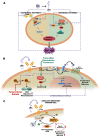Autotaxin-Lysophosphatidate Axis: Promoter of Cancer Development and Possible Therapeutic Implications
- PMID: 39062979
- PMCID: PMC11277072
- DOI: 10.3390/ijms25147737
Autotaxin-Lysophosphatidate Axis: Promoter of Cancer Development and Possible Therapeutic Implications
Abstract
Autotaxin (ATX) is a member of the ectonucleotide pyrophosphate/phosphodiesterase (ENPP) family; it is encoded by the ENPP2 gene. ATX is a secreted glycoprotein and catalyzes the hydrolysis of lysophosphatidylcholine to lysophosphatidic acid (LPA). LPA is responsible for the transduction of various signal pathways through the interaction with at least six G protein-coupled receptors, LPA Receptors 1 to 6 (LPAR1-6). The ATX-LPA axis is involved in various physiological and pathological processes, such as angiogenesis, embryonic development, inflammation, fibrosis, and obesity. However, significant research also reported its connection to carcinogenesis, immune escape, metastasis, tumor microenvironment, cancer stem cells, and therapeutic resistance. Moreover, several studies suggested ATX and LPA as relevant biomarkers and/or therapeutic targets. In this review of the literature, we aimed to deepen knowledge about the role of the ATX-LPA axis as a promoter of cancer development, progression and invasion, and therapeutic resistance. Finally, we explored its potential application as a prognostic/predictive biomarker and therapeutic target for tumor treatment.
Keywords: ATX-LPA axis; ENPP2; autotaxin (ATX); cancer; lysophosphatidic acid (LPA); lysophosphatidylcholine (LPC); lysophospholipase D (lysoD); tumor microenvironment.
Conflict of interest statement
The authors declare no conflicts of interest.
Figures




References
Publication types
MeSH terms
Substances
Grants and funding
LinkOut - more resources
Full Text Sources
Medical
Miscellaneous

